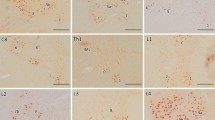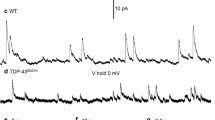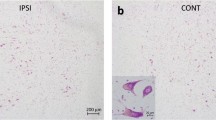Abstract
The spinal cord of 20 patients with amyotrophic lateral sclerosis (ALS) and 5 patients with lower motor neuron disease (LMND) were investigated immunohistochemically using anti-human excitatory amino acid transporter 1 (EAAT1) and EAAT2 antibodies which are the astrocytic transporters. The purpose of the study was to examine relationships between EAAT1 and EAAT2 immunoreactivity and degeneration of anterior horn neurons. Specimens from 20 patients without any neurological disease served as controls. In controls, spinal cord gray matter was densely immunostained by antibodies, whereas the white matter was generally not immunostained. In motor neuron disease (MND) patients, EAAT1 immunoreactivity was relatively well preserved in the gray matter despite neuronal loss of anterior horn cells. On the other hand, EAAT2 immunoreactivity in anterior horns correlated with the degree of neuronal loss of anterior horn cells: in the patients with mild neuronal depletion, anterior horns were densely immunostained by the antibody, whereas in the patients with severe neuronal loss, EAAT2 expression was markedly reduced. Degenerated anterior horn cells frequently showed a much denser EAAT1 and EAAT2 immunoreactivity around the surface of the neurons and their neuronal processes than that observed in normal-appearing neurons. There was no difference in the expression of EAAT1 and EAAT2 immunoreactivity between LMND and ALS patients. These findings suggest that in the early stage of degeneration of anterior horn cells, EAAT1 and EAAT2 immunoreactivity is preserved in the astrocytic foot directly attached to normal-appearing neurons, whereas levels of EAAT1 and EAAT2 protein rather increase in the astrocytic foot directly attached to degenerated anterior horn neurons; the latter effect most probably reduces the elevated glutamate level, compensates for the reduced function of astroglial glutamate transporters, or represents a condensation of EAAT1 and EAAT2 immunoreactivity secondary to loss of neurites and greater condensation of astrocytic processes. Thus, we demonstrate a difference in EAAT1 and EAAT2 immunoreactivity in different stages of progression in ALS, as a feature of the pathomechanism of this disease.
Similar content being viewed by others
Author information
Authors and Affiliations
Additional information
Received: 8 September 1999 / Revised, accepted: 28 October 1999
Rights and permissions
About this article
Cite this article
Sasaki, S., Komori, T. & Iwata, M. Excitatory amino acid transporter 1 and 2 immunoreactivity in the spinal cord in amyotrophic lateral sclerosis. Acta Neuropathol 100, 138–144 (2000). https://doi.org/10.1007/s004019900159
Issue Date:
DOI: https://doi.org/10.1007/s004019900159




